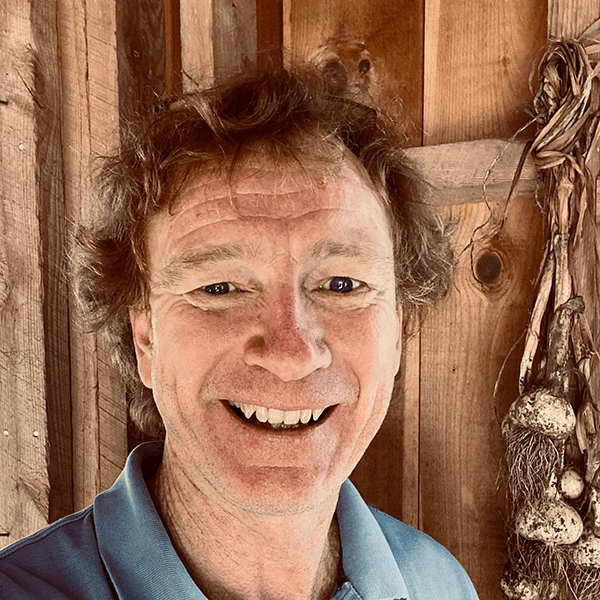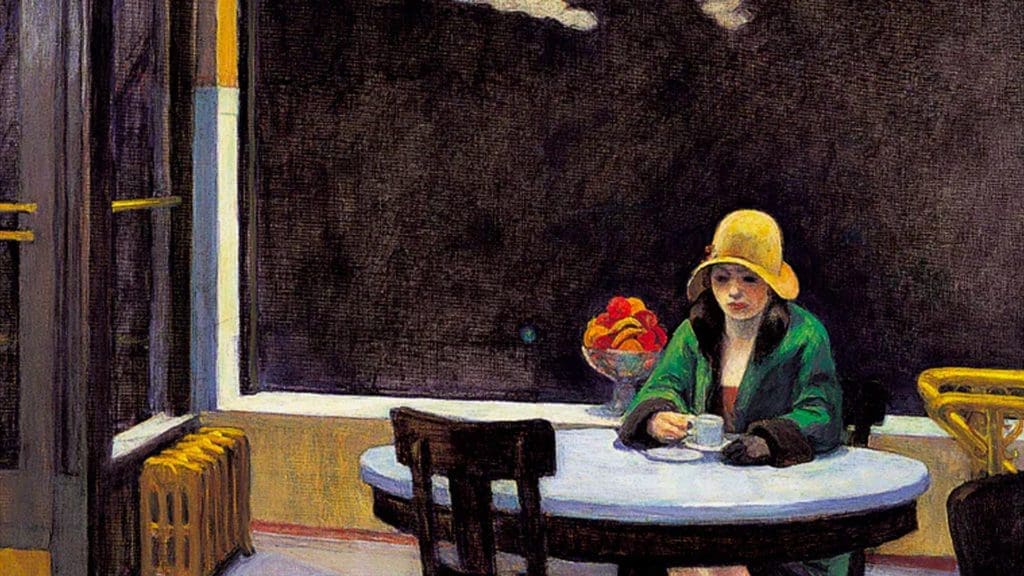I
“Is this all it comes to? A hole in the ground, and dirt?”
A pile of dirt lies next to an open grave. Workers drape a green carpet on top of the dirt pile before anyone arrives for the final prayers. It’s as though they’re trying to hide the dirt, trying to save us from the embarrassment the dirt causes. We’re embarrassed because the dirt asks a question we can’t answer, and our inability to answer the question wounds our pride. So we hide the dirt under a green carpet.
The blue Ford tractor with the backhoe that they used to dig the grave is half-hidden thirty yards away, behind a white oak, far enough to be outside consciousness, but close enough to be convenient.
I’m driving up the curved cemetery lane. Grandma Dot is next to me. We’re alone in the car together. We approach the grave, the dirt under the rug, the varnished casket, and the people gathering, and she says, “Is this all it comes to? A hole in the ground, and dirt?”
It’s a question and a confession. She’s ninety-two. She’s gone to church all her life, sung in the choir, still teaches the adult Sunday school. Despite her grounding in churchgoing—or maybe because of it?—she confesses the crisis of the dirt: its suggestion of the possibility that the meaning of her life is nothing more than the dirt that will one day hold her.
“Is this all it comes to?” There’s no answer to her question. The awkwardness and embarrassment we feel when we see the pile of dirt is the mirror in which we see how we sag. That hissing sound is the air leaking out of our inflated sense of power and permanence.
We would prefer to forget that we are creatures; prefer to forget that the world will continue when we’re gone; prefer to forget that we have a birthday and therefore have a death day, even if we don’t know yet what day that is. Gravity pulls us down. The dirt, the sea, the wind, the fire: they reclaim us. There are no exceptions.
And yet the kind of presence, the kind of attentiveness that allows the question to form and be spoken, may itself be the answer. The answer is the soul where the question forms, and the body that gives it voice: “How long, O Lord? Will you hide your face from me forever?”
There’s fear in the questions of my grandmother, in the cry of the psalmist. But not only fear. There’s also doubt. And desire. And hope.
But let’s start with fear. The church’s role in public conversations is to use the gifts and wisdom of our Christian inheritance to see, and help others see, the fear in our shared common life. There’s a connection, unlikely as it seems, between my grandmother’s confession at the dirt pile and how the church can embody a different way of relating to the fears that hold us prisoner.
The fear at the grave is the mother of all the fears that nip and gnaw at our shared common life. The fear of being dependent and vulnerable, the fear of the stranger, the fear of scarcity, the fear of being shamed or held in contempt, the fear of losing or being lost, the fear that the old ways of finding order and making meaning have disappeared forever—all of these receive their distressing power from the free-floating anxiety that the pile of dirt evokes.
Not everyone believes this, but I think it’s true: all our fears are the children of the fear of annihilation.
The church’s role in public conversations is to use the gifts and wisdom of our Christian inheritance to see, and help others see, the fear in our shared common life.
“Fear,” Hannah Arendt wrote, is “the inspiring principle of action in tyranny” and “is fundamentally connected to that anxiety which we experience in situations of complete loneliness.”
It’s worth pausing on this observation, habituated as we are to social-scientific rather than psycho-spiritual understandings of our shared common life. Arendt is connecting political theory to human experience. She’s connecting fear—a normal feeling for us all when faced with the grave—to the essence of a certain type of social and political life, tyranny.
To be clear, Arendt is not tracing causation: just because people in a constitutional republic feel fear does not mean that the republic is now suddenly a tyranny. Instead, Arendt is offering us a picture and inviting us to look at it with her, to see that the fear that rises from complete loneliness and separation is the principal dynamic in a polity where the power of one—whether an autocrat or an unchecked majority—dominates over all.
Two obvious points. First, our society is filled with loneliness and fear. Second, that’s not a good thing for our shared common life. If Arendt is correct, while fear does not cause tyranny, it is the stinking muck in which that snake can grow and one day emerge.
Our love of guns, our love of money, our love of security, our addictions: these are the disordered loves that rise from our fear and loneliness; these are the ways we try to manage the unmanageable and control the uncontrollable. I imagine you can add to the list of disordered loves that warp our shared common life. They are, after all, legion.
When I was a student preacher, the instructor said, “Tell the people the bad news first so they’re ready to hear the Good News.” So, the bad news.
We are afraid and lonely, and our fear and loneliness distort our shared common life. Further, there is an institution that could be a healing force in the wider culture but isn’t. That institution is the church.
The church has the language to understand how fear works, and we have practices of community that embody fear’s undoing. The church right now, having been assigned to the private realm by an arrangement underwritten by a certain modern understanding of secularity, seems unsure how to reclaim its public voice. A privatized religious sphere works until your society loses track of what needs to be held in common in order to remain a society and your politics becomes disconnected from any consideration of what counts as “good.” Without things held in common, and without a vision of the good for which politics aims, there is no future. Without a future, fear replaces hope.
At that point, it becomes clear that you need a church. Or something like it.
You need a church that will take a seat at the grown-ups’ table (where tech gurus, finance moguls, media personalities, and politicians and their funders currently sit) and act like the wise woman she is: an unanxious presence, unfazed by the froth and buzz of breaking news, unintimidated and untempted by the worldly powers sitting at the table with her (the men in suits with private jets), confident that she sees things about humanity and community that others cannot see. Confident in the saving power of Christ revealed through his vulnerability, and the undoing of fear that comes through self-emptying service in love. Confident in caritas.
Our churches, however, are thoroughly assimilated into the world as it is, and so we have lost our saltiness and surrendered our authority to cast out fear. The same political divisions that are in the culture are in the church; we’ve lost the ability to imagine more humane economic arrangements than what we currently have; we resign ourselves, just like the culture around us, to a feeling that the future will be the present extended indefinitely. Churches are as afraid as the culture, and fear crushes creativity.
We are afraid and lonely, and our fear and loneliness distort our shared common life.
A thoroughly assimilated church has nothing to add to public conversations, because a thoroughly assimilated church simply echoes what’s already being said, perhaps adding a theological riff here or a little moral language there, like a parsley garnish on a breakfast plate at Denny’s. Useless.
When we accept the terms set by culture warriors and false prophets, we Christians, who ought to know better, co-sign on a contract to buy a house framed with the two-by-fours of division. We are then at the mercy of those who gleefully set fire to this house: those who profit from faction and delight in destruction. Fear begets fear.
The bad news, then, is that fear and loneliness warp our shared common life. The further bad news is that the church isn’t yet claiming its authority to be a healing presence in the wider culture.
The first hint of good news begins with a scene in New Hampshire in October, when the sugar maple leaves are red, yellow, and neon green. It’s a very subtle hint of good news—so subtle, in fact, that you might mistake it for more bad news. But it promises new life.
A bus filled with old women from Delaware comes north on a package tour to take pictures of the fall foliage. They stop at a farm store near the state highway, where the bus driver extends his arm to help the women as they climb down the stairs. They buy packets of pumpkin-print napkins, boxes of maple candy, and then climb back onto the bus.
Next, they stop in the village at the old white church with the clear windows. The church, where once the Spirit came in tongues of flame, is mostly a museum now, a place where people come to look at things. The old people die, and the young people stay away.
The town historian, who worships in the church every Sunday along with a dozen other old New Hampshire women, tells the tourists gathered near the altar about the first settled minister, Harvard-educated, who came to town before there was a United States and preached there until he died at the beginning of the next century. She shows the women from Delaware the nearly three-hundred-year-old pewter Communion plates and goblets sitting in a line on shelves behind the glass cabinet doors. The tourists take pictures with their handheld computers, walk down the aisle, exit through the wood door with the black iron latch whose rattle echoes off the chipped horsehair plaster narthex walls, and proceed down the granite steps back to the bus. The driver starts the engine, and the growling diesel drowns out the morning crickets.
Unless nostalgia is your thing, this scene is bad news. It’s the familiar story of decreasing church attendance, declining relevance, and the growth of the “nones.” It’s a picture of a church—and this can include very busy, very big churches too—that simply leaves the world as it’s currently arranged. Even in its good works, it avoids the transformative encounter with loneliness and fear.
But if new wine is your thing, this scene is good news: the old wineskin is going. Some may grieve the old church and her going, and I grieve with them. But the retirement of the tired ways makes space for the refreshment that lives, as Hopkins says, “deep down things.”
Refreshment, renaissance, renewal, reformation: pick any word from the list. The church needs—our churches need—any one of them, or all four. Remember, we’re into the good news now: take heart, the reformation is coming; the Holy Spirit is at work in places we can already see, and in corners we don’t yet notice.
To see this need for reformation is good news.
Jemar Tisby argues in these pages for a reformation grounded in a recovery of the doctrine of the imago Dei. Yes. And. What is the content of the image of God present in each person? Inherent dignity surely is correct, but even more: What is the gesture of, what is the movement of, or, as Tisby asks, what is the ethic of the image of God in us?
The answer to this question leads us to the practices of Christian community that embody fear’s undoing.
My grandmother and her sister knew this would be the last time they’d be in the same room together on earth. My great-aunt sat on her bed, in her room in the dementia ward, tired from our outing to Winstead’s. She was in the dementia ward only because she had become a little daffier recently—she knew what was going on.
It was time to say goodbye; I’d be bringing my grandmother back to Ohio tomorrow, and we were due at the Kansas City airport early. My grandmother and her sister had been together for a year short of nine decades now; for most of that time they had lived three miles from each other and had talked on the phone every day.
My grandmother bends down in front of her sister, saying, “Jo, let me get your shoes off. You need to lie down.”
“Oh Do, I’m so tired,” she says using her pet name for her sister. My aunt is sitting on the edge of her bed like a schoolgirl, her legs dangling, chin to her chest, eyes hidden, probably closed. My grandmother, kneeling, pulls one shoe off and rubs her little sister’s foot. Then she pulls off the other shoe and, cradling her sister’s ankles with her right arm while pushing herself off the floor with her left, lifts her sister’s feet up to the bed so that she’s lying down now, resting.
“How’s that, Jo? Here, let me get a blanket.”
“Oh Do, that’s lovely. I think I’ll take a little nap.”
My grandmother leans over and gives her sister a kiss on the cheek. We say goodbye. She takes my arm as we walk out the door and down the hall.
The gesture of my grandmother tending her sister is how the image of God gets embodied. It is the gesture of Jesus taking the towel and the basin and washing his friends’ feet—the work of those who were the lowest and the least. It’s a curious thing: we express our highest human dignity, and are most fully God’s image bearers, when we choose to empty ourselves of position, station, or status and become servants.
If the reformation of the church is to be grounded in the recovery of the imago Dei, and if the imago Dei is most fully manifested when a person empties herself in order to encounter and accompany another, then a reformed church for today—the church that has the authority to cast out fear—seeks to lose herself for others.
How could it not be so? It’s the way of love.
The Great Commandment sounds like a Hallmark Card until you realize that when Jesus tells us to love one another, he isn’t talking about having warm feelings. He’s talking about a courageous, countercultural act of self-surrender, “the awful daring of a moment’s surrender / Which an age of prudence can never retract,” as Eliot has it.
The church that has recovered this movement of the imago Dei has remembered its vocation. It regains its prophetic witness. Its insistence on, and commitment to, the power of sacrificial love is a scandal to the world of getting and spending, competing and dominating, shaming and demeaning. Its trust in the power of sacrificial love, and its confidence in the triumph of that love at the end of time, means the church can resist the temptation to seize worldly power and win now. No longer assimilated to the culture, the church is salt again.
This renewed, reformed church is not a thing that can change the world. It is the community that lives as an already changed way of being in the world. The church is, differently; we Christians are, differently.
Fear is undone by the way of being that is the daily practice of self-emptying love, in the community of those who so practice. Fear is not eliminated; it just loses its power to keep us prisoners.
My grandmother answered her own question—“Is this all it comes to? A hole in the ground, and dirt?”—when she knelt at her sister’s feet in self-surrender. The answer, which is paradoxically a non-answer to the fear of nothingness, is an act. The answer is a Way, not a program. The answer is the Word, which is not a word but a person. Because the answer is a person, the answer to fear and loneliness and the meaning of life is not thinking something correctly but loving someone concretely.
Czech philosopher Jan Patočka (1907–1977) has a name for the community of people who have experienced the crisis when the curtain is pulled back from everyday certainties, exposing the inescapable problem of living in the knowledge of death, of finitude—he calls this community “the solidarity of the shaken.” Patočka was not talking about the church, but we might take the “solidarity of the shaken” to define the church that we need: the church that does not hand out answers but practices self-emptying love. Fear doesn’t disappear then. It just finds its proper size.
The church that’s a museum has no power to cast out fear because it is just another thing among things. No one is shaken.
The assimilated church has no power to cast out fear because it replicates the fear-mongering culture. Outrage is confused for shakenness.
The solidarity of the shaken is the community that is awake to the problem of being alive in this time in history, in this time of disenchantment and the reductive understanding of humans as mere bundles of appetites. Martin Koci, a Patočka scholar, interprets the solidarity of the shaken this way: “[It] is the community guarding being against its reduction to some thing.” Humans are beings, not things.
We are afraid and lonely, and our fear and our loneliness distort our shared common life. One of the gifts of the church in public conversations is to calm the fear, so that the larger social body can act with civility and dignity, and think with clarity. A little yeast leavens the loaf.
We who follow the Way can calm the fear, because we’ve seen the dirt pile at the dug grave, wrestled with its temptation to despair, and responded to its question with love.
The solidarity of the shaken is the community in Christ’s Holy Spirit.
It would be foolish to say that we, the church, have solutions to loneliness and fear. We don’t have solutions. We have abundant life.
More concretely, what might the church and other groups of Christians do today to cast out fear? How do we reclaim, using Patočka’s terminology, our human being from the worldly powers that want to make us things? Here are two practices that we Christians engage in that form us in self-giving generosity and make it possible for us to embody “be not afraid” in public.
First is the practice of worship. In worship, in thanksgiving and praise to God, we are at our most countercultural, because worship requires getting ourselves out of the centre. Fear thrives in self-preoccupation. Love, occupied with the beloved rather than the self, casts out fear.
Worship is a mode in which we put aside ourselves in order to allow God’s life to be alive in us. I’ve been critical of churches throughout this essay, but I’ve worshiped in almost every kind of church in North America that you can imagine, and faithful churches, of whatever denomination or demographic, are united in worship that points beyond itself to God.
Churches are public places, and worship is a public act. Reading the Gospel aloud is a public witness. We are in the world. Getting in right relationship with God and others by receiving the presence of Jesus in worship is a public practice that undoes fear.
A second concrete expression of Christlike self-emptying is the practice of conversation. By “conversation” I mean the human encounter in which people seek truth together. This requires humility and listening, the opposite of grandstanding and lecturing. Listening well in a conversation calls for self-emptying, not unlike the inner disposition for worship and prayer. While people may begin conversations fearfully, I’ve never experienced a conversation that ended fearfully when people were listening deeply. Even when there was disagreement.
Where are conversations about human flourishing from a Christian theological horizon happening? Any place where Christian artists and thinkers gather can potentially be a place where these conversations occur: seminaries, Christian colleges, non-religious community colleges and universities that have Christian professors and instructors, institutes, professional conferences, journals, festivals, Substack newsletters, Patreon pages, and collaborations like this magazine’s Breaking Ground project. Christians don’t necessarily listen any better than anyone else, but we do have a standard by which to judge. Our standard is a theology that says we flourish when we empty ourselves in our encounters with others—we lose our life in order to find it. Deep listening in conversation is an exercise in self-emptying, and a mark of the solidarity of the shaken.
Creative, collaborative thinking, deep listening in conversation, and worship are concrete practices that undo fear.
In the end, it comes back to the pile of dirt and the fact of finitude. When Hannah Arendt wrote that fear is “the inspiring principle of action in tyranny,” she was writing in the context of dehumanizing horrors that drew their demonic power from that fear, as was Jan Patočka. Neither was a Christian, but both saw the pure, clear spring of the human heart and its polluted, foul perversion.
Powerful forces drive fear in our culture, and that fear threatens to form us into the kind of fear-saturated people in which tyranny can root. Partisan win-lose political games goad us into fractious enmity. Consumer-driven, market-worshiping economic processes grind us with merciless demands and turn gifts into commodities. Outrage-stoking media ecosystems scream at us with reptilian aggression. The message is “You’re a loser. You are a thing that can be exchanged for another thing. Be afraid.”
The apostles in the first days after Christ’s resurrection—the very first “solidarity of the shaken”—were afraid. Their practice, not yet reified into church buildings or bishops or creeds, was a way of being in the world that upended cultural expectations and conflicted with the religious authorities.
Their practice was focused on the person who kept showing up and saying, with the authority of one who had wrestled with the graveside pile of dirt and won by losing, “Be not afraid. I am with you.”





